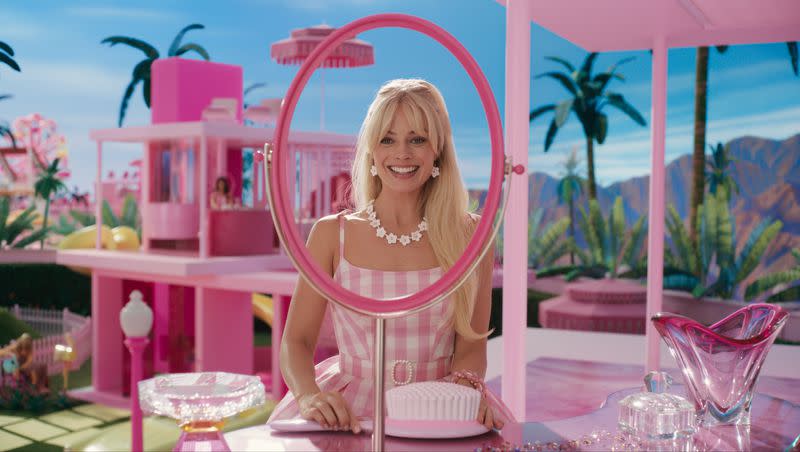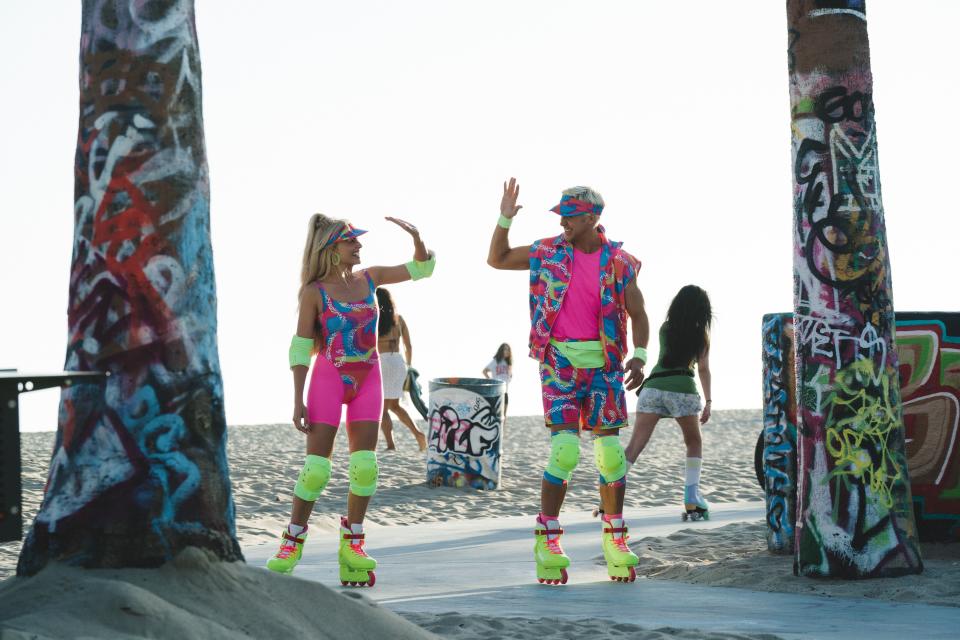The whimsy and wit of ‘Barbie’

Barbie dolls have generated controversy since they were invented in 1959. The classic doll has impossible proportions, a winning smile and perfect hair, leading some to criticize the doll for its impact on young girls’ body image. But also, Barbie has received praise for having a doll for nearly every profession — from president to reporter.
And the tension between those two cultural flashpoints was at the heart of Greta Gerwig’s latest film “Barbie.” The film explores messaging around Barbie by creating two worlds and is, essentially, a coming-of-age story. There’s some innuendo and language, which is why the film is rated PG-13, but there’s no graphic content.
The neon pink Barbie Land is home to Barbies living rosy lives — the real world, on the other hand, is where Barbie encounters both sexism and a group of girls who think she herself has set unrealistic beauty standards. This tension guides the film. Where the film succeeds when this tension is artfully portrayed. It misses the mark when it feels ham-fisted.
Related
Is ‘Barbie’ a family-friendly movie? A look at why the upcoming movie is rated PG-13
She’s an icon, she’s a legend, she’s Barbie: The legacy of Barbara Millicent Roberts
The film has decidedly serious material, even though it’s a romp packaged in pink. There are humorous one-liners throughout and plenty of dramatic irony. It’s a would-be mashup of “Legally Blonde” and “Mona Lisa Smile,” but peppered with more innuendo and relies more on didactic dialogue than subtle visual cues.
“Barbie” echoes some other films like “The Matrix,” “The Wizard of Oz” and “2001: Space Odyssey.” That in combination with contemporary pop music and slang make it the kind of film teenage daughters could enjoy with their mothers and both would walk away seeing music and film references unique to their generations.
It’s a film that shouldn’t be underestimated. And, as the undertone of the movie consistently signals to the audience, neither should Barbie.
Barbie (Margot Robbie) undergoes a heroine’s journey. When she starts to ask questions about life and death, she’s presented with two options by Weird Barbie (Kate McKinnon): a pair of high heels, representing the iconic, hyper-femme Barbie Land, or a pair of Birkenstocks, symbolizing the real world.
Even though she wants to pick the high heels (who can blame her), she’s compelled to take the Birkenstocks. It’s a classic motif of hero tales — Barbie has to move from her personal paradise to endure difficulty and see who she can become.

When girls play with dolls, they sometimes project themselves onto the doll. A girl longing to be a teacher or doctor in the future can see a doll as a symbol of aspiration. In a twist, humanity is projected onto Barbie and she has to tumble down to the real world, her wide-eye optimism and naivete challenged in the process.
In some ways, to fully appreciate the dramatic irony of this twist, you would have had to played with Barbies as a kid. And that condition seems to be by design.
When playing with Barbies, you create a world and a place for yourself in it without complications. Growing up, and leaving that space of unfettered imagination and creation, disrupts it. So, Gerwig’s creation of two opposing worlds and Barbie’s journey through them is an exaggerated portrayal of that particular universal experience.
There’s another universal experience in the film: working out femininity and independence. It’s not the pioneer in films showing women embrace femininity and success — that’s likely reserved for “Legally Blonde” — but it’s certainly echoing that message.
However, the film’s definition of success seemed to rely heavily on what jobs Barbie had and it could have done more to include other measures of success — like building successful relationships and helping others.
As Barbie straddles between Barbie Land and the real world, she becomes glum — the real world doesn’t seem all that great to her after Barbie Land. In Barbie Land, a Barbie is president and the Barbies run the world while the Kens sit on the sidelines.
The opposite is true in the real world.
Barbie and Ken (Ryan Gosling) then have opposite character arcs. Barbie becomes aware of the stark differences between the two worlds and takes issue with the real world, while Ken sees those same differences and tries to bring the real world back into Barbie Land to make it a Kendom instead.
Even though Ken once doted on Barbie and followed her to the real world, he sees her differently after going to the real world.
These two worlds represent opposite ends of a spectrum. As Robbie put it in an interview with ABC News, Barbie Land is something “beyond feminist.” Robbie explains that while Barbies run Barbie Land, Kens have no status. Conversely, the real world is replete with sexism, which Ken embraces.

The opposite ends of the spectrum are defined by interactions Barbie and Ken have in each world. But the film could have done less hand-holding to those conclusions and used more visual cues to make the same point.
Like my friend asked me, “What happened to show, not tell?”
The concept of the two worlds and how Barbie and Ken are transformed in them is an original and genius way of capturing the cultural zeitgeist and critiques about Barbie. In fact, it was likely the best way to communicate that message. Still, at times, the dialogue felt over the top.
“By this point, ‘Barbie’ has begun to do a lot more telling and a lot less showing; its themes are presented like flat-lays of Barbie outfits, delivered in lines of dialogue that are supposed to be profound but come off as lifeless,” Stephanie Zacharek wrote for Time magazine.
But even though more showing and less telling would have made a more compelling film, it’s worth wondering if the intention of the film was to be somewhat overwhelming at times.
The film’s greatest successes came from its over-the-top set. The film contributed to a pink paint shortage, per NPR. Every shade of pink is splashed onto the screen when in Barbie Land: from ballerina pink to millennial pink. It almost overwhelms the viewer, but its fantastical nature sparks nostalgia.
Seeing Barbie in the world creates the same sense of overwhelm. It’s startling to see the stark differences, but this over-the-top approach develops the crux of the film.
At the crux of the film are questions about how the Barbies and the Kens can reconcile their seemingly irreconcilable differences. It’s worth watching the film to see how the ending shakes out.
Robbie’s performance as “Barbie” is likely to be a career high for the Australian actress who has already established herself as an actress with range. She shines because she manages to embody her character’s story and change with the character.
As for Gosling — it wasn’t his best performance, but he managed to make Ken transform from a charming Backstreet Boys kind of character to a flat character. He isn’t a typical favorite for comedies, but this significant foray into the genre was a success for him.
The whimsy and wit of “Barbie” fashion the film’s questions about human nature into a pretty pink package that’s chock full of substance while also being an entertaining film.

